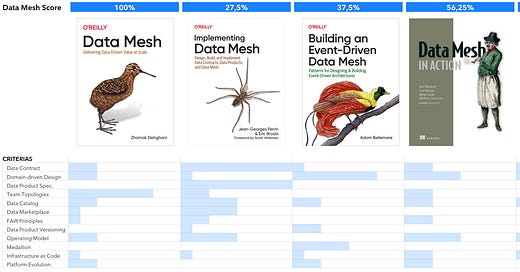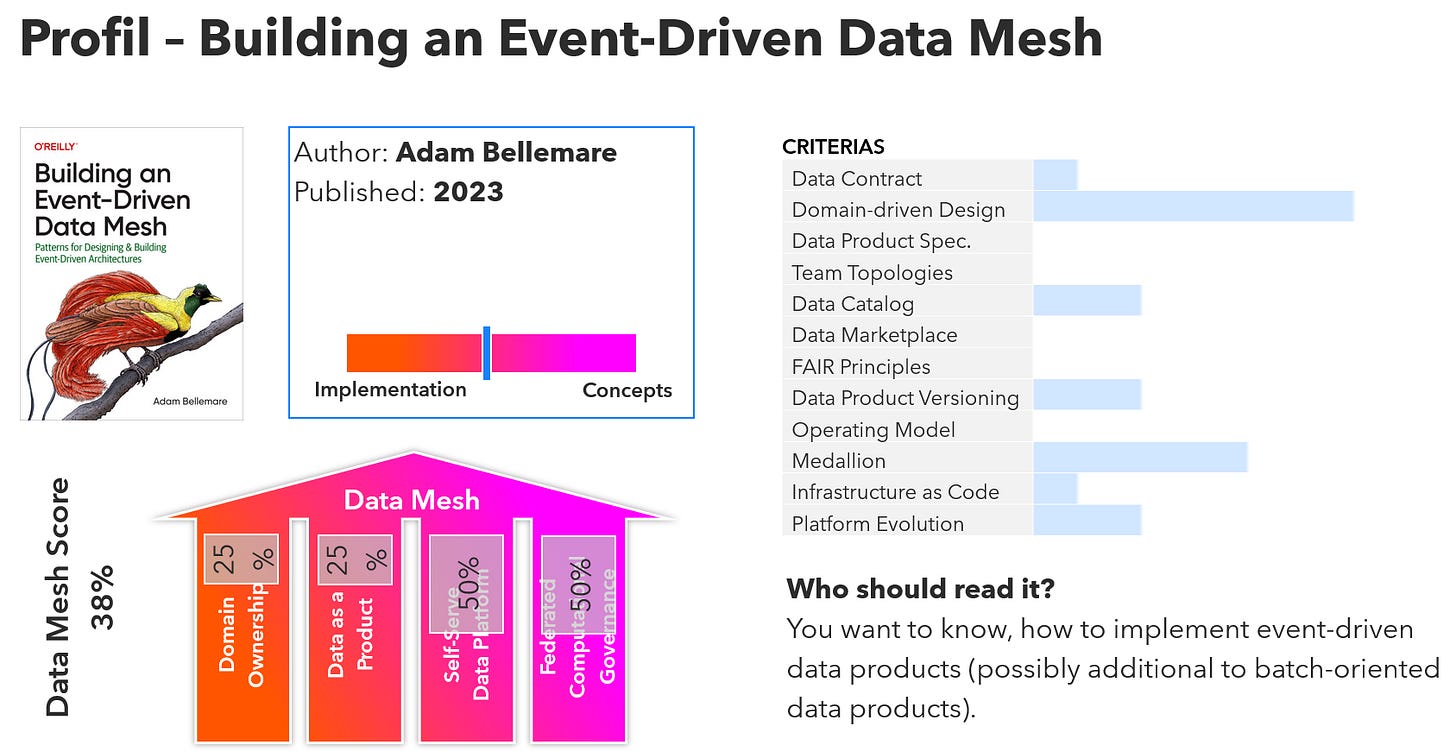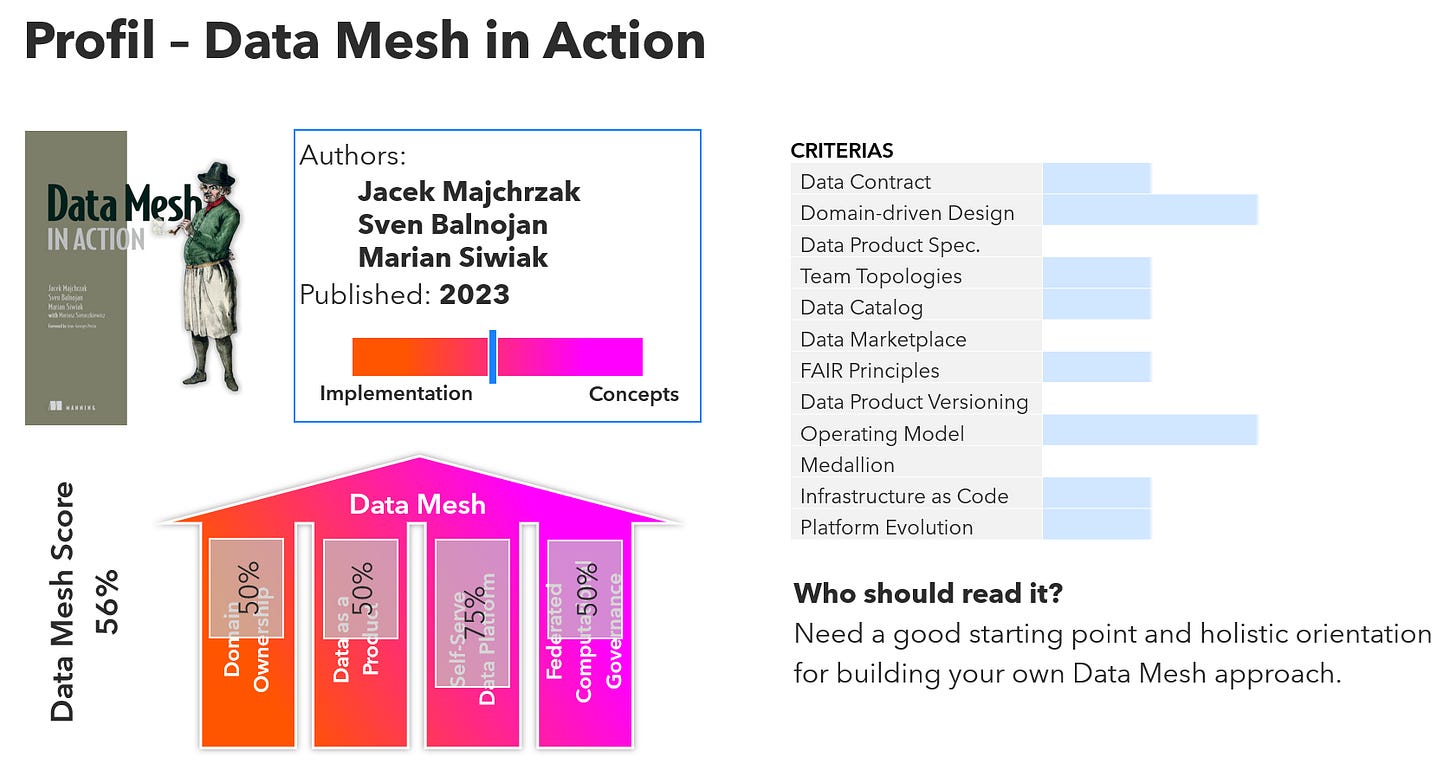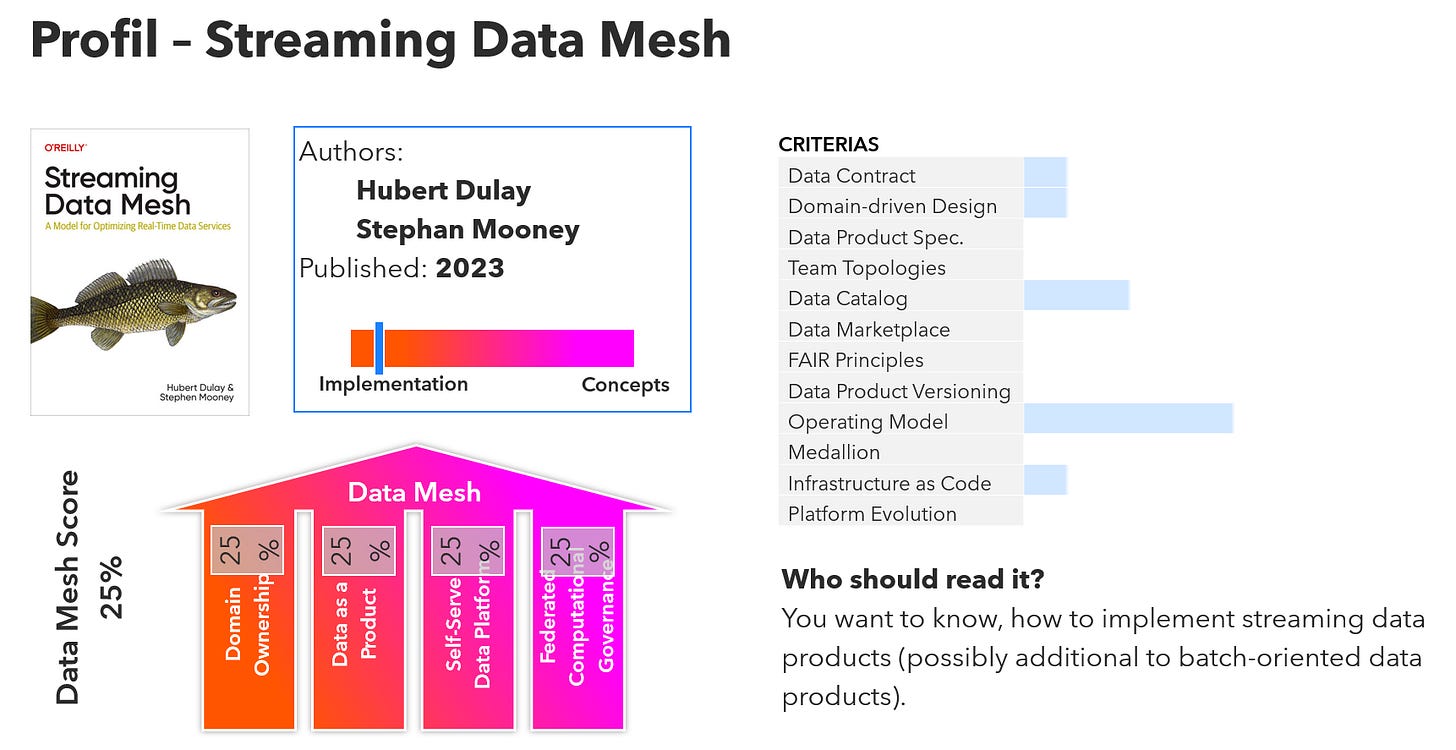Even if we see advancements in many areas from where Data Mesh started in 2019, we can still learn from the original idea. Books are like a update for your brain. Choose the right one and get better.
Overview
I found these 5 books about Data Mesh and went through them to understand their focus, how they interpret Data Mesh and which concepts are used.
Fig. 1: The 4 Data Mesh books I review in this article
In the upper part you can find a Data Mesh Score, where I have evaluated, how strong the concept of Data Mesh is really covered. For sure is Zhamak’s book here the benchmark.
I choosed the following criterias to look for in the books, as I had often discussions about and wanted to see how they are covered.
Data Contract - An agreement between data producers and consumers specifying the schema, semantics, SLAs, and quality expectations of data products—ensuring reliable and predictable data exchange
Domain-driven Design (DDD) - A software design approach emphasizing modeling based on business domains; in data mesh, it aligns data ownership and products to business domains for decentralized, domain-aligned data management
Data Product Specifications - Standards for defining the structure and metadata of data products, like Open Data Product Specification (ODPS) - focuses on describing the full lifecycle and characteristics of a data product or Open Data Contract Standard (ODCS) - defines data contracts formally, including schema, validation rules, and usage policies
Team Topologies - An organizational model that defines team structures and interactions (e.g., enabling teams, platform teams). Helps implement data mesh by aligning teams with domain responsibilities and promoting fast flow of change
Data Catalog - A searchable inventory of metadata about data assets (including data products) that enables discovery, understanding, and governance across domains
Data Marketplace - A curated environment (internal or external) where data products are published, discovered, and consumed—often including pricing, usage terms, and ratings
FAIR - Principles - A set of guidelines to make data Findable, Accessible, Interoperable, and Reusable—essential for discoverability and usability of data products in a mesh architecture
Data Product Versioning - Managing changes to data products over time. Often follows Semantic Versioning:
MAJOR.MINOR.PATCHformat to signal breaking vs non-breaking changes and includes backward compatibility, deprecation policies, and change documentationOperating Model - Defines how data mesh functions e. g. through processes (e.g., product lifecycle), roles (e.g., data product owner), organization (team structures),
collaboration models, and shared services (e.g., governance, observability)
Medallion Architecture - A layered data design (typically Bronze → Silver → Gold) for incrementally refining raw data into high-quality, trusted data products
Infrastructure as Code - Managing and provisioning infrastructure through machine-readable code, enabling repeatable, automated, and consistent environments for deploying data mesh components
Platform Evolution - An approach to incrementally building the data platform like Minimal Viable Platform (MVP) - A first iteration that supports essential data product creation/consumption or Thinnest Viable Platform (TVP) - An even leaner version focused only on must-have capabilities to test value early and enable rapid iteration
The Books
The bible of Data Mesh is still Zhamak Dehghani’s seminal book about “Data Mesh”. Until today it is crucial for the basic understanding. Sometimes I have the impression there are 3 kinds of readers. Those who just read the prolog. Those who read until chapter 3 (Principle of Data As a Product) and Those who read it end to end.
Fig. 2: Data Mesh by Zhamak Dehghani
As you can see here, a detailed coverage of each Data Mesh pillar is given, as an indication whether this book is rather implementation-oriented or focusing on the concepts of Data Mesh.
Comparable to the others, this book goes deep into the ideas and concepts, no toher will. It covers many aspects like Team Topologies very well while it is limited to recommend specific technologies or implementation examples.
From the 3rd part of the book - “How to Design the Data Mesh Architecture” - it really is important to have already a deeper understanding of modern data management concepts to get the whole picture.
The second book I checked was “Implementing Data Products”. First I thought, perfect having an implementation-oriented book as often a guidance is urgently needed in todays discussions. Indeed it is strong on many implementation aspects but surprising on others for me.
Fig. 3: Implementing Data Mesh by Jean-Georges Perrin and Eric Broda
Maybe this book should rather be named “Implementing Data Contracts for Data Products” as this is really the focus I see. It is herefore for sure the most detailed I found and cover this topic really well with many examples. Somehow not surprisingly as they reference to Bitol’s standards in this area and is maybe the reference book for everyone want to work with these.
Best for those who want to learn to leaverage data contracts for data products.
The book “Building an Event-Driven Data Mesh” shouldn’t be your start in the data mesh world and maybe also not into event-driven architectures. But If you look for something as a developer, that connects both topics, this book is the right one for you.
Fig. 5: Building an Event-Driven Data Mesh by Adam Bellemare
The book focus on event-driven data products, giving you good basics and showing what is important. It works with concepts like Domain-driven Design and Medaillon architecture and shows to you how to build a event-driven platform for data mesh over time. I see a good balance between explaining basic concepts and showing how to bring them in practice.
This book is clearly implementation driven, but also helpful for architects and other roles to understand deeper this possible flavor of Data Mesh.
The next book “Data Mesh in Action” really delivers what the title promised for me. It closes a gap between theory and implementation. If you need a quick start to the topic as someone responsible introducing Data Mesh in the organization, this would be the book I would recommend.
Fig. 4: Data Mesh in Action bei Jacek Majchrzak, Sven Balnojan and Marian Siwiak
It covers the the pillars of Data Mesh very well, work with them and go deeper into methodology like how to use Domain-driven Design and a clear architecture language for designing domains and data products. You can finde a well integrated case study, guiding you through different aspects. Best for Enterprise and Data Architects and people working on the data strategy.
“Streaming Data Mesh” skip theory except a short introduction, to focus on implementing what the title promises - a streaming data mesh. This means other aspects are there, but not covered deeper and you really get a guidance on how to do it.
Fig. 6: Streaming Data Mesh by Hubert Dulay and Stephan Mooney
The book focus a lot on Open Source components to show and explain streaming concepts and how to build a architecture on it.
What surprised me a little bit was despite the technical focus the chapter about decentalized data teams, which seems to reflect specific experiences and is an added value and maybe a reason for non-developers to have a look into this book.
Also the chapter about feature stores seems to be specific compared to other books, but add avalue and makes this book a unique experience.
Best for developers, data scientists and data engineers.
Conclusion
Until today there is no alternative for me to read books to learn new things in detail. ChatGPT don’t give you the overview, details and experiences of the author the same way. Going to a training gives you the idea and maybe first exercises. For sure, nothing beats practicing. But reading helps to give you the complete picture and the opportunity to always come back to deepen your understanding.
Data Mesh is still a huge topic, even if the hype flattened a little bit and focus shifts more to data products and other topics. We can learn a lot from diving deep into the topic, if we later live it or not.
Comparing these 5 books showed me, that there are still very different perspectives about what Data Mesh can be in practice and how it can be implemented. The focus and perspectives differ a lot. Therefore as for most technical topics it is recommended to read more than one book to get the complete and differentiated perspective on.
As Zhamak Deghahni now went a step further with Nextdata, maybe we can hope for a new and reviewed book about closing the gap to implementation from her perspective. I think no one started higher, learned faster, was more often questioned and discussed Data Mesh more intensively than her.
But over the time the topic has developed a momentum of it’s own. New experts arise and it was interpreted in specific directions.
Personal Recommendation
This is the order I would recommend if you would start today with Data Mesh:
Data Mesh by Zhamak Deghani - It gives you the holistic understanding and I recommend to read it end to end at least twice before going on.
Data Mesh in Action by Jacek Majchrzak, Sven Balnojan and Marian Siwiak - Especiallly for Data Architects and Data Strategists this is an excellent starting point which shows well how it could work and what all this means, including the organizational side.
Implementing Data Mesh by Jean-Georges Perrin and Eric Broda - Data Contracts are an important success factor for a today Data Mesh and this is the best book to introduce you to how it could work in this context.
Building an Event-Driven Data Mesh by Adam Bellemare - This is more focussed on the event-driven architecture and not an introduction to data mesh. But it gives you context to many important aspects and for an advanced Data Mesh you will come to these aspects over time.
Streaming Data Mesh by Hubert Dulay and Stephan Mooney - Last but not least, this is very similar like the book before. Here you can find a more implementation-oriented approach and if streaming and real-time is already a topic for you before Data Mesh you should start here already earlier.








